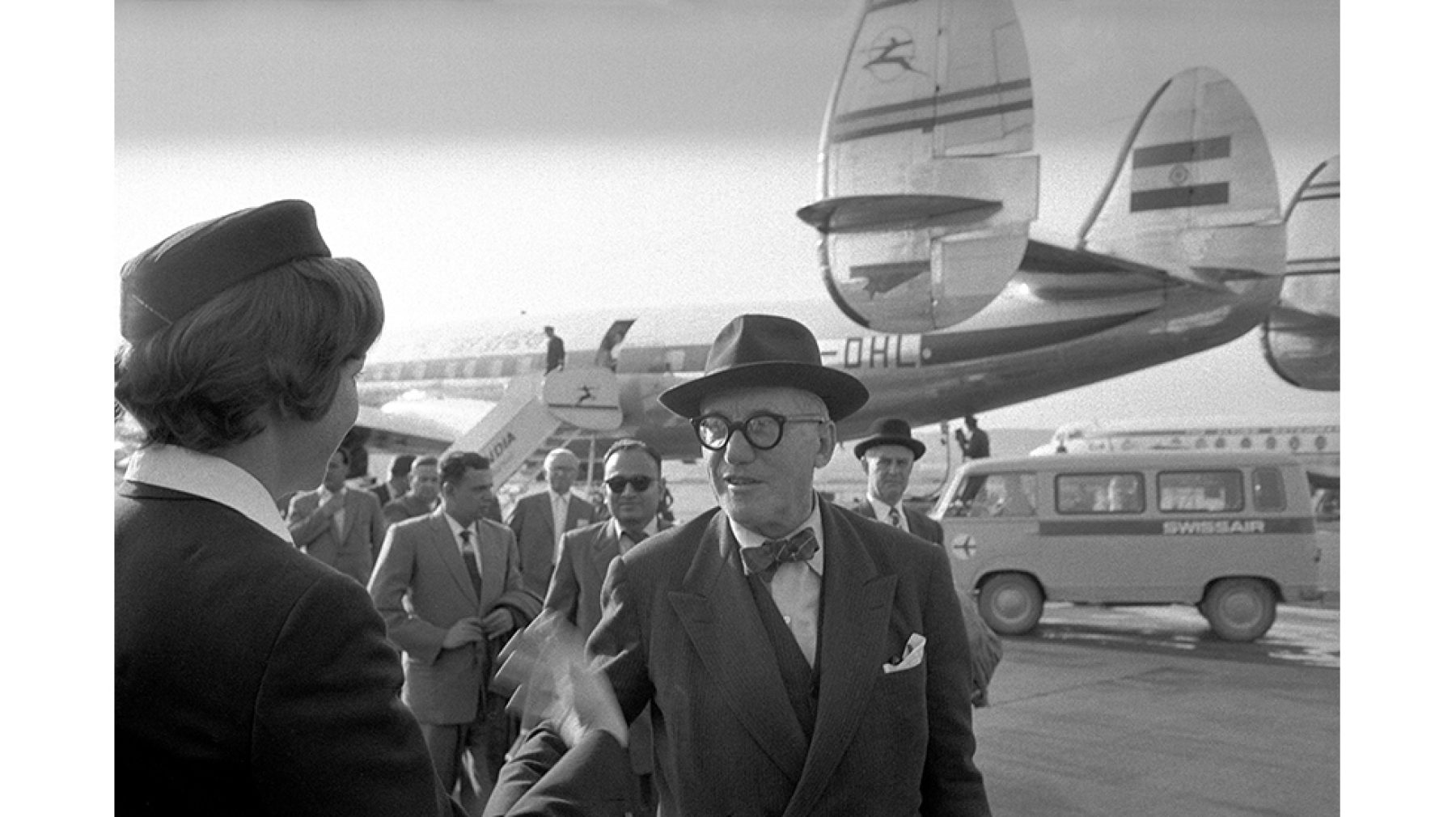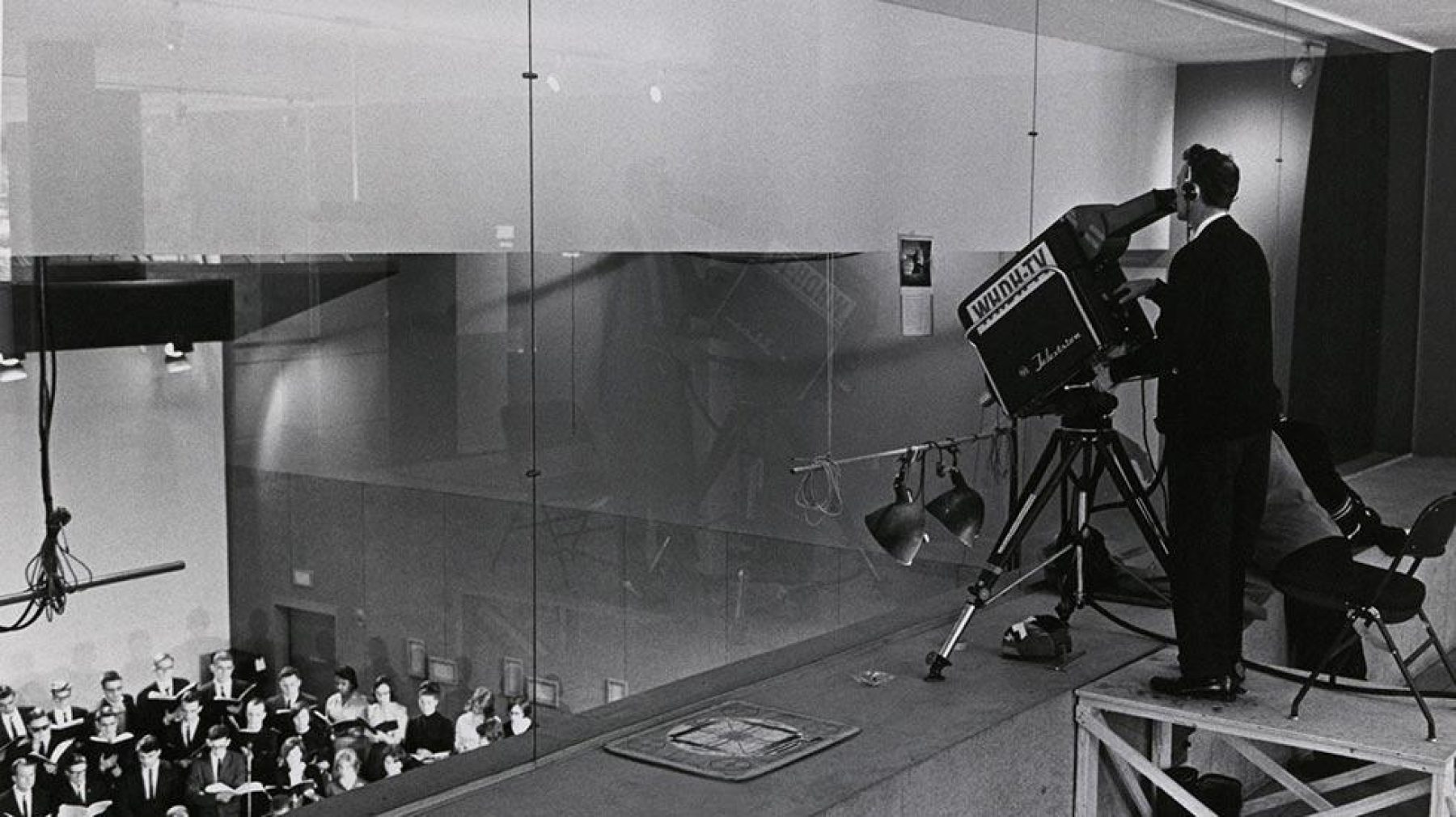This exhibition was on view from February 14 to April 7, 2013.
Brute
The Carpenter Center for the Visual Arts at Harvard University is architect Le Corbusier’s only building in North America, and one of the last to be completed during his lifetime. In 2013, the Carpenter Center for the Visual Arts will celebrate its 50th anniversary.
For this occasion artists Katarina Burin and Amie Siegel conceived of the exhibition Brute. Engaging with the Carpenter Center building, Brute encompasses a set of new commissions by six international artists, a speculative exhibition model deploying objects and artworks from the Harvard University collections, as well as a series of events and performances. Burin and Siegel use the exhibition form itself as non-hierarchical process of discovery, inquiry, and collaboration.
The focus of the exhibition is on a set of specially-conceived works by internationally-acclaimed artists Nairy Baghramian, Anna Barriball, Barbara Bloom, Katarina Burin, Alexandra Leykauf, and Amie Siegel. These artists cross generations and represent diverse practices that reinterpret design and architectural history in playful and ambiguous ways, often subtly undermining predisposed ideas of genius and historical importance. Questions about the circulation and visibility of design reverberate throughout the exhibition, as do concerns of gender, collections, archives, (heroic) architecture, and cinematic space—the here and elsewhere of modernism. The role of the document as “fact” versus fiction, and the formal gestures of remaking, re-printing, and repurposing become an analogue to the building’s varied use over time. Several participating artists have worked collaboratively and often involve cross-disciplinary practices—from sculpture, drawing, and photography to film projection, video, and modes of display. An audio recording of "Clairvoyance," a short story by J.A. Gibson, playing simultaneously in the Carpenter Center and on Alvar Aalto’s 1960’s “Listening Station” in Harvard’s Woodberry Poetry Room, doubles the real and imagined space of a fictional architect.
Drawing on the tremendous yet often hidden wealth of the Harvard University collections, the exhibition sets artworks in dialogue with objects and images. A custom-designed architectural model of the Carpenter Center serves as a fictional double of the exhibition itself. Since early 2013, the Harvard Art Museums placed a moratorium on loans of artworks from the collections due to the ongoing building renovation of the Fogg Museum, the Carpenter Center’s closest neighbor. The fictional exhibition presented in the model is populated by scale reproductions of artworks in the actual show as well as absent, desired works from the Harvard Art Museum collections. Simultaneously architectural model, abstraction of the building, and conjectural scaled-down exhibition (contained in the show that it reproduces), this Carpenter Center replica is a lateral unveiling of the exhibition’s oblique, democratic approach.
Over the course of the show, a series of events will take place in the building—film projections, talks and performances—which further the exhibition’s propositional discourse with the building. An evening series of “film happenings” will take place in the Main Lecture Hall, where Le Corbusier’s long unused series of parallel projection windows will be reactivated in a multiple projection event. The program will also include events relating to the Bauhaus-inspired curricular history of the Carpenter Center as the department of “Light and Communication”—“re-staging” events that in fact never occurred, further blurring boundaries between fiction, fact, anecdote, gossip and the tall tales of history.
Additional viewing hours:
Amie Siegel
Lecture Hall Viewing Hours: Mon, Wed–Fri, 10:30–12:30 pm, Tue: 10:30–3 pm, Sat: 11 am–3 pm, Sun: 1–3 pm. No screenings Sun, Feb 17; Sat, Mar 30; Sun, Mar 31; and Sun, Apr 7.
Alexandra Leykauf
2nd Floor Viewing Hours Tue & Thu: 12–2 pm Wed: 1-3 pm, Sat & Sun: 1–5 pm. Evenings 5–8 pm during exhibition events (see below)
Clairvoyance by J.A. Gibson on Alvar Alto's Listening Station. Please contact the Woodberry Poetry Room for hours.
Model Playground: Pedagogy & Architecture at the Carpenter Center for the Visual Arts, Joana Pimenta, Film and Visual Studies PhD and Visual and Environmental Studies Teaching Fellow, talks to the Derek Bok Center for Teaching and Learning at Harvard University, about the role of education in the exhibition Brute.
Nairy Baghramian
Working in sculptural installations and photography, Baghramian employs interior design, literature, and art- historical debates around minimalism to comment on materiality, manufacture, and display. Her work examines political and social systems of power, encompassing questions of context, institutional framing, and the production and reception of contemporary art. Baghramian’s work possesses a sense of immediacy that emphasizes the physicality of the object itself. Her sleek, polished aluminum pieces and cast rubber forms are often arranged in intimate mise-en-scènes that highlight the absence of a body while imbuing the forms themselves with bodily presence. Born in Isfahan, Iran, in 1971, Baghramian lives and works in Berlin. Her recent exhibitions include Illuminations at the 54th Venice Biennale; a two-person show with Phyllida Barlow at Serpentine Gallery in London; and shows at Kunsthalle Baden-Baden, Sculpture Project Münster 07, and Kunsthalle Basel.
Anna Barriball
Barriball was born in 1972 in Plymouth, England, and received her MA from Chelsea College of Art. Her work hinges on minimal interactions with objects and often steps between the parallel languages of drawing and sculpture. Much of her practice explores and depicts the accretion of time – from the length of time it takes for a candle to burn down to the repetitious activity of taking graphite rubbings from objects that bare the traces of their use or function. In her hands a map of the world is transformed into a strange expanse of shimmering substance, or the bounce of a rubber ball on a piece of paper creates the effect of a cosmic explosion. Her interventions produce objects that combine a minimalistic rigor and the seemingly endless endeavor to make sense of the world of objects by empirical study. Solo exhibitions include MK Gallery, Milton Keynes, UK, Fruitmarket Gallery, Edinburgh, UK, and Frith Street Gallery, London. Barriball lives and works in London.
Barbara Bloom
Bloom is a multimedia installation artist working with assemblage, collage, photography, and design, who examines questions of history and archiving, often exposing the subliminal ideologies of modern visual culture. Bloom was born in Los Angeles, in 1951. She attended Bennington College in Bennington, Vermont, and studied with John Baldessari at the California Institute of the Arts in Valencia. She won the Aperto prize for best young artist at the 1988 Venice Biennale, and has since had one-person shows at the Serpentine Gallery, London (1990), the Wexner Center for the Visual Arts, Columbus, Ohio (1996), and the Museum of Contemporary Art, Los Angeles (1998). Her exhibition "As it were ... So to speak" opens in March, 2013 at the Jewish Museum, New York. She lives and works in New York City.
Katarina Burin
Burin’s drawings, structures, larger installations and collages are influenced by the documentation and circulation of historical architecture and design imagery. Works from her “PA” project have been presented recently in solo exhibitions at Ratio 3 Gallery in San Francisco and Galerie M29 in Cologne, as well as in a book published earlier this year. Previous group and solo exhibitions by Burin include Andreas Grimm Galerie, New York and Munich; Lucile Corty, Paris; Clockwork, Berlin; Country Club, Cincinnati; Form/Content, London, White Columns, New York; Participant Inc, New York; and Galerie Max Hetzler, Berlin. Burin received her MFA from Yale University and her BFA from University of Georgia. She is a recent recipient of the Schloss Solitude stipendium, the Dedalus Master of Fine Arts Fellowship and has done residencies at the MuseumsQuartier in Vienna, Skowhegan, Yaddo and MacDowell. Most recently, Burin was announced as an ICA/Boston 2013 Foster Prize finalist.
Alexandra Leykauf
Leykauf was born in 1976 in Germany. She began her studies at the Akademie der Bildenden Kunsten, Neurenberg, in 1996, and continued her education in Amsterdam, in both the Gerrit Rietveld Academie (Audiovisual and Photography) and at the Rijksakademie van Beeldende Kunsten. The artist has had numerous solo exhibitions including Domaine de Lézigno and Sassa Trülsch (2012), Martin van Zomeren and Carl Freedman Gallery (2011), Frieze Art Fair and Kunstverein Nürnberg (2009) and Foto Museum Amsterdam (2006). She received a grant from Kunstfonds Bonn and the Akademie Schloss Solitude fellowship in 2011. Selected writings include Frieze, ZERODEUX, FOAM Magazine, and Artforum. Her work is in the public collections of the Centre Pompidou Centre Pompidou and Musée d’Art moderne de la ville de Paris, among others.
Amie Siegel
Ranging from photographs, sound, video and film installations, and feature films for the cinema, American artist Amie Siegel’s work re-orientates the fictions within documentary practices. Her work has been exhibited at the Whitney Museum of American Art, MoMA/PS1, Walker Art Center, Hayward Gallery, ICA Boston, KW Institute for Contemporary Art, Berlin and the Kunstmuseum Stuttgart. Screenings include Cannes Film Festival, Berlin International Film Festival, New York Film Festival, The Museum of Modern Art, The National Gallery of Art, and the Harvard Film Archive among many other museums and cinematheques. She has been a fellow of the DAAD Berliner-Künstlerprogramm, the Film Study Center at Harvard University, the Guggenheim Foundation and a recipient of the ICA Boston’s Foster Prize.
Selected Press
Art New England
Feb 2013
Looking Back
The Harvard Crimson
Feb 2013
A Brutal Celebration - Carpenter Center Turns 50
Brute was supported by a grant from the Graham Foundation for Advanced Studies in the Fine Arts. Founded in 1956, the Graham Foundation for Advanced Studies in the Fine Arts makes project-based grants to individuals and organizations and produces public programs to foster the development and exchange of diverse and challenging ideas about architecture and its role in the arts, culture, and society. LC1 Sling Chair, Cowhide, courtesy of Design Within Reach.

Archive
Explore more of our rich history through our archive.


